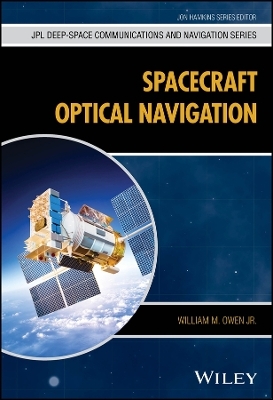
Spacecraft Optical Navigation
John Wiley & Sons Inc (Verlag)
978-1-119-90443-4 (ISBN)
Spacecraft Optical Navigation provides detailed information on the planning and analysis of spacecraft imagery to help determine the trajectory of a spacecraft. The author, an experienced engineer within the field, addresses the entirety of celestial targets and explains how a spacecraft captures their imagery.
Aimed at professionals within spacecraft navigation, this book provides an extensive introduction and explains the history of optical navigation, reviewing a range of optical methods and presents real world examples throughout. With the use of mathematics, this book discusses everything from the orbits, sizes, and shapes of the bodies being imaged, to the location and properties of salient features on their surfaces.
Specific sample topics covered in Spacecraft Optical Navigation include:
History of various past spacecraft, including Mariner and Viking, Voyager, Galileo, NEAR Shoemaker, and Cassini, and flight hardware, star catalogs, and stereophotoclinometry
Cameras, covering the gnomonic projection (and deviations from it), creation of a digital picture, picture flattening, and readout smears
Modeling optical navigation observables, covering apparent directions to an object, star, and limbs or terminators, and orientation of cameras
Obtaining optical navigation observables, covering centerfinding for stars and resolved and unresolved bodies, and using opnav data in orbit determination
Spacecraft Optical Navigation is an ideal resource for engineers working in spacecraft navigation and optical navigation, to update their knowledge of the technology and use it in their day-to-day. The text will also benefit researchers working with spacecraft, particularly in navigation, and professors and lecturers teaching graduate aerospace courses.
WILLIAM M. OWEN JR. is an Optical Navigation engineer at the Jet Propulsion Laboratory, California Institute of Technology, USA. He has been a member of the technical staff at Jet Propulsion Laboratory since 1979 and has been semi-retired since 2010. He received his PhD in 1990 and is a past member of Division A Fundamental Astronomy, Division F Planetary Systems and Astrobiology, and more.
List of Figures ix
Preface xi
Acknowledgement xv
1 Introduction 1
1.1 Purpose 1
1.2 Definitions 1
1.3 Notation 2
1.4 Rotations 2
1.5 Left-handed Coordinate Systems 7
2 History 9
2.1 The Early Years: Mariner and Viking 10
2.1.1 Mariner 9 12
2.1.2 Viking 12
2.2 Coming of Age: Voyager 13
2.3 Innovation and Workarounds: Galileo 15
2.4 Landmarks: NEAR Shoemaker 18
2.5 Maturity: Cassini 20
2.6 Autonomy: Deep Space 1, Stardust, Deep Impact 21
2.6.1 Deep Space 1 22
2.6.2 Stardust 23
2.6.3 Deep Impact 23
2.7 Flight Hardware 24
2.8 Development of Enabling Technologies 24
2.8.1 Computers 24
2.8.2 Detectors 25
2.9 Star Catalogs 26
2.10 Stereophotoclinometry 27
2.11 Future Missions 27
2.12 Optical Navigation Outside JPL 28
2.13 Summary 28
3 Cameras 29
3.1 The Gnomonic Projection 30
3.2 Deviations from the Gnomonic Projection 31
3.2.1 Optical Aberrations 31
3.2.2 Keystone or “Tip/Tilt” Distortion 32
3.3 The Creation of a Digital Picture 32
3.3.1 Vidicon Detectors 33
3.3.2 CCD Detectors 34
3.3.3 Active Pixel Sensors 35
3.4 Picture Flattening 35
3.5 Readout Smear 37
4 Modeling Optical Navigation Observables 43
4.1 Introduction 43
4.2 The Apparent Direction to an Object 44
4.3 The Apparent Direction to a Star 46
4.4 The Apparent Direction to the Limb or Terminator 48
4.5 The Orientation of the Camera 53
4.5.1 Three Pointing Angles Are Known 53
4.5.2 Two Pointing Angles Are Known 54
4.5.3 Primary and Secondary Axes 55
4.5.4 Rotation into Camera Coordinates 56
4.6 Modeling the Gnomonic Projection 56
4.7 Modeling Distortions and Misalignments 57
4.7.1 The Acton–Duxbury Model 57
4.7.2 The OpenCV Distortion Model 58
4.8 Conversion into Pixel Coordinates 58
4.9 Summary of Optical Navigation Geometry Calculations 59
5 Obtaining Optical Navigation Observables 61
5.1 Introduction 61
5.2 Centerfinding for Stars 61
5.2.1 Circular Gaussian Model 62
5.2.2 Elliptical Gaussian Model 63
5.2.3 Circular Cauchy Function 63
5.2.4 Centerfinding Using the Marginal Distribution 63
5.3 Reflectance Laws 64
5.3.1 Lambert Scattering 66
5.3.2 Lommel–Seeliger Scattering 66
5.3.3 Minnaert Scattering 67
5.3.4 Hapke Scattering 67
5.4 Centerfinding for Unresolved Bodies 67
5.5 Centerfinding for Resolved Bodies 68
5.5.1 Correlation 68
5.5.2 Limb Scanning 69
5.6 Centerfinding for Landmarks 71
6 Using Opnav Data in Orbit Determination 75
6.1 Dynamic Partials 75
6.2 Star Partials 78
6.3 Optical Partials 79
6.3.1 Pointing Angles 79
6.3.2 Focal Length 80
6.3.3 Distortion Parameters 80
6.3.4 Pixel Layout (“K Matrix”) Parameters 81
6.3.5 Optical Axis Pixel Coordinates 81
6.4 Constructing the List of Estimated Parameters 81
6.5 Camera Calibration 82
6.5.1 Time-Varying Camera Parameters 85
Appendix A The Overlapping Plate Method 87
A.1 Development of Fundamental Catalogs 87
A.2 The Astrographic Catalog 88
A.3 Development of the Overlapping Plate Method 88
A.4 Application to Groundbased Astrometry 89
Glossary 91
References 97
Index 101
| Erscheinungsdatum | 25.10.2024 |
|---|---|
| Reihe/Serie | JPL Deep-Space Communications and Navigation Series |
| Verlagsort | New York |
| Sprache | englisch |
| Themenwelt | Technik ► Maschinenbau |
| ISBN-10 | 1-119-90443-9 / 1119904439 |
| ISBN-13 | 978-1-119-90443-4 / 9781119904434 |
| Zustand | Neuware |
| Informationen gemäß Produktsicherheitsverordnung (GPSR) | |
| Haben Sie eine Frage zum Produkt? |
aus dem Bereich


